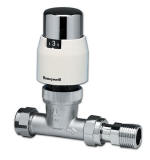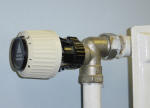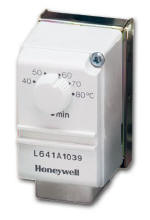Modern Central Heating
4 Central heating - Controls
 |
Modern central heating systems incorporate a number of controls. These turn parts of the system on and off according to a number of criteria and control temperature levels. In large houses the control systems can be very sophisticated; for a typical house, however, they are fairly straightforward. This page has been adapted from an article written by the National Energy Foundation and it examines the controls normally found in a vented water-based central heating system. The three port valve and the pump are not really controls (they respond to the controls) but they been included in the left-hand graphic. | |
NB The page on solid fuel central heating contains more information on special controls for solid fuel appliances. |
To work effectively a basic modern central heating system needs four
main controls:
|
In a larger system it might be worth adding:
|
 |
A timer or programmer A seven day timer is recommended (left). This makes it possible to have different settings for Saturday and Sunday, and even different days of the week if required. Note that even if the timer is ON or the heating switch is set to CONSTANT the heating system will not work if the the room or radiator thermostats are turned down. |
 |
 |
A room thermostat A room thermostat switches the system ON and OFF as necessary. It works by sensing the air temperature - if the temperature rises above the chosen setting, say 20 degrees Celsius, the heating is switched off (but not the hot water - assuming it's controlled separately). The thermostat is best located in a living room, rather than the hallway, so it is not affected by the front door being opened. Do not confuse the main room thermostat with TRV - thermostatic radiator valves (these are mentioned below). In some larger houses there will be two thermostats because the house is divided into 2 zones - each with separate controls. Note you can also buy programmable thermostats. This is combined time switch and room thermostat that allows the user to set different periods with different target temperatures for space heating. |
NB The thermostat does not control the speed at which a room warms up. |
 |
Thermostatic radiator control valves (TRVs) Normally, one radiator should not be fitted with a TRV (so it's always on), unless the boiler is fitted with a flow meter to detect when all TRVs are closed. This radiator may be a bathroom towel rail, or in the same room as the room thermostat. It is not a good idea to have a TRV on the radiator in the same room as the main thermostat, because if it turns the radiator off, the low temperature in the room can mislead the main thermostat into thinking the whole house is cool. Similarly, if there is a fire in the same room as the thermostat the heat from the fire may fool the thermostat into switching off the heating. |
 |
 |
Thermostatic controls on the hot water system The room or space thermostat and the hot water thermostat should be wired up to the boiler in what is known as an interlock - if both the house and hot water are at the required temperature, the boiler will be switched off. NB TRVs alone are not sufficient for boiler interlock. Some boilers contain a thermostat which controls the temperature of the water sent to the cylinder and the radiators. Without the interlock this thermostat will sense the drop in water temperature and fire the boiler. After a few minutes it will stop as the water heats up. This stop/start process is known as 'short' or 'dry cycling' . The cylinder thermostat is normally fitted between one quarter and one third of the way up the cylinder. There is no point in setting the thermostat above 65 degrees as it will only waste energy; it also increase the risk of scalding. |
 |
Automatic bypass valve |
Not really a control but worth mentioning. An automatic bypass valve controls water flow in accordance with the water pressure across it, and is used to maintain a minimum flow rate through the boiler and to limit circulation pressure when alternative water paths are closed. A bypass circuit must be installed if the boiler manufacturer requires one, or specifies that a minimum flow rate has to be maintained while the boiler is firing. The installed bypass circuit must then include an automatic bypass valve (not a fixed-position valve). Care must be taken to set up the automatic bypass valve correctly, so as to achieve the minimum flow rate required (but not more) when alternative water paths are closed. It also keeps noise down. | |
More advanced controls |
Intelligent Heating Controllers |
Most of these advanced controls are unnecessary in modest-sized houses. |
|
Weather Compensators These measure the temperature inside or outside and can make the heating system respond accordingly. On mild mornings, for example, the heating comes on later, on cold ones it comes on sooner. Some of the simpler ones are not very expensive and usually replace the room thermostat. |
||
|
Boiler Energy Managers There are several types of boiler energy manager. They are devices intended to improve boiler control using a number of features. These include weather compensation, optimum night start, frost protection, load compensation, hot water override and so on. They are usually unnecessary. |
|
|
|
Full Zone Control In large houses the pipework can be divided into zones, each with its own thermostat and timer. This means that different parts of the house can be maintained at different temperatures for different periods of time. |
|
|
The Energy Saving Trust publishes recommendations regarding central heating specifications.http://www.est.org.ukIn addition the Department for Communities and Local Government publishes a guide "DOMESTIC HEATING COMPLIANCE GUIDE" which specifies minimum standards for new and replacement heating systems. |
||
except where acknowledged